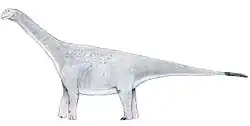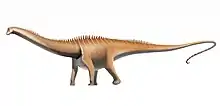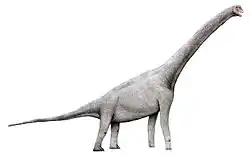| Bustingorrytitan Temporal range: Late Cretaceous, | |
|---|---|
.jpg.webp) | |
| Forelimb bones | |
| Scientific classification | |
| Domain: | Eukaryota |
| Kingdom: | Animalia |
| Phylum: | Chordata |
| Clade: | Dinosauria |
| Clade: | Saurischia |
| Clade: | †Sauropodomorpha |
| Clade: | †Sauropoda |
| Clade: | †Macronaria |
| Clade: | †Titanosauria |
| Clade: | †Lithostrotia |
| Genus: | †Bustingorrytitan Simón & Salgado, 2023 |
| Species: | †B. shiva |
| Binomial name | |
| †Bustingorrytitan shiva Simón & Salgado, 2023 | |
Bustingorrytitan (meaning "Bustingorry's giant") is a genus of lithostrotian titanosaur from the Late Cretaceous (Cenomanian) Huincul Formation of Argentina. The type species is Bustingorrytitan shiva.[1]
Discovery and naming
.jpg.webp)
In 2001, several sauropod skeletons were uncovered at the "Bustingorry II" site at Villa El Chocón, including remains belonging to both Choconsaurus and Bustingorrytitan.[2] This sauropod was announced in a conference the same year by Simón, and received the informal name of "Sauropodus".[3] It was first described in 2011, in a thesis by María Edith Simón.[4]
It was named as a new genus and species of titanosaur in 2023. The generic name, "Bustingorrytitan", honors Manuel Bustingorry, the person who owns the land where the fossils were found, combining his name with the Greek titan, in reference to its large size. The specific name, "shiva", is named after the Hindu god Shiva, who destroys and transforms the universe, in reference to the Cenomanian-Turonian faunal turnover.[1]
.jpg.webp)
The holotype of Bustingorrytitan is MMCH-Pv 59/1-40, a partial skeleton including a tooth, vertebra, possible ribs, a scapula, a humerus, a femur, tibiae and a fibula. Four specimens are known, together including parts of the dentary and postcranial skeleton.[1]
Description
Using femur allometry, the weight of Bustingorrytitan was estimated to be approximately 67.3 tonnes (66.2 long tons; 74.2 short tons), making it one of the largest titanosaurs. It is also likely that the specimen doesn't belong to a fully grown animal.[1] However, estimates based on limb bone allometry have been criticized as unreliable, and when applied to large sauropods regularly produce higher mass estimates than those produced by other methods.[5][6][7]
Classification
Bustingorrytitan was entered into a phylogenetic analysis and recovered as a member of the Lithostrotia, which itself is recovered as a subclade of the Saltasauroidea, in contrast to most analyses. The results of the analysis are shown in the cladogram below:[1]
| Lithostrotia |
| |||||||||||||||||||||||||||||||||||||||||||||
Paleoecology
Bustingorrytitan was recovered from the Huincul Formation alongside two other gigantic titanosaurs, Argentinosaurus and Chucarosaurus. The three are not closely related to one another, which means that giant titanosaurs evolved multiple times within Eutitanosauria.[1]
References
- 1 2 3 4 5 6 Simón, M. E.; Salgado, L. (2023). "A new gigantic titanosaurian sauropod from the early Late Cretaceous of Patagonia (Neuquén Province, Argentina)". Acta Palaeontologica Polonica. doi:10.4202/app.01086.2023.
- ↑ Simón, Edith; Leonardo Salgado, and Jorge O. Calvo. 2017. A new titanosaur sauropod from the Upper Cretaceous of Patagonia, Neuquén Province, Argentina. Ameghiniana 55. 1–29. Accessed 2020-03-16. doi:10.5710/AMGH.01.08.2017.3051
- ↑ Simón, Edith, (2001). A giant sauropod from the Upper Cretaceous of El Chocon.
- ↑ Simón, M.E. (2011). Los dinosaurios saurópodos de la Formación Huincul (Cenomaniano superior) en Villa El Chocón (Neuquén): osteología, relaciones filogenéticas, aspectos paleoecológicos, y paleobiogeográficos. 493 pp. Unpublished Thesis, Facultad de Ciencias Exactas, Físicas y Naturales, Universidad Nacional de Córdoba, Córdoba
- ↑ "No, David Attenborough, you can't tell how heavy a dinosaur was from the circumference of its femur". Sauropod Vertebra Picture of the Week. 2016-01-12. Retrieved 2024-01-04.
- ↑ Bates, Karl T.; Falkingham, Peter L.; Macaulay, Sophie; Brassey, Charlotte; Maidment, Susannah C. R. (2015). "Downsizing a giant: re-evaluating Dreadnoughtus body mass". Biology Letters. 11 (6). doi:10.1098/rsbl.2015.0215. eISSN 1744-957X. ISSN 1744-9561. PMC 4528471.
- ↑ Campione, Nicolás E. (2017). "Extrapolating body masses in large terrestrial vertebrates". Paleobiology. 43 (4): 693–699. doi:10.1017/pab.2017.9. eISSN 1938-5331. ISSN 0094-8373.











